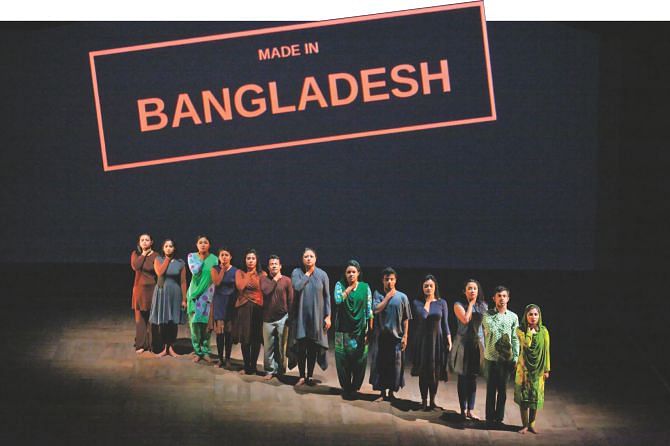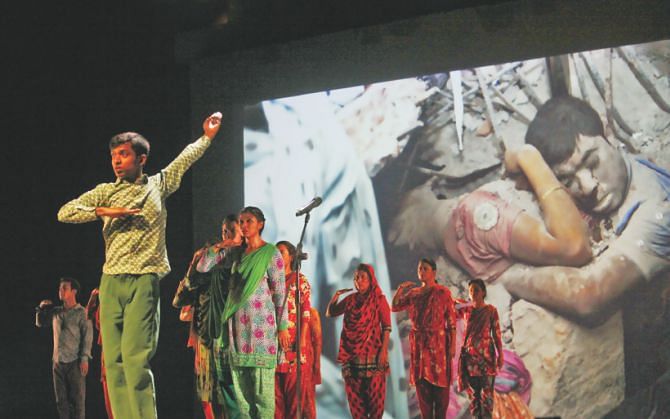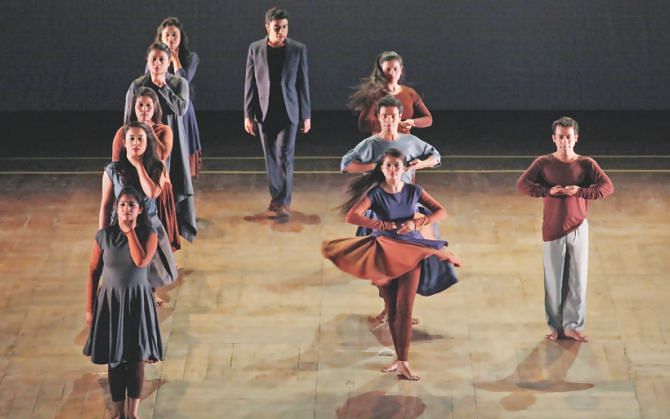Made in Bangladesh with Blood, Sweat, Tears and Hunger
Made in Bangladesh with Blood, Sweat, Tears and Hunger

Despite lack of natural resources, tremendous pressure of overpopulation and persistent political violence, Bangladesh has maintained a 6+ percent GDP growth rate over the last 5 years. How has that happened? With endless blood, sweat, tears and HUNGER. We're hungry: for three meals a day, for economic freedom, for recognition of our hard work, for dignity. Racing on an uneven playing field means our labour has to remain cheap. But then what's labour when life here is cheap?
“Made in Bangladesh”, the dance production which had its Bangladesh premiere on January 26, puts the working condition in the RMG industry on stage – creating the ambiance of a “sweat shop”, where workers are put to a Herculean test. They have to work harder, faster, better – all the while keeping labour cost cheaper than competitors. There are no bathroom breaks either, we're told.

Dance director Helena Waldmann and co-choreographer Vikram Iyengar use the signature spin, hand and footwork of Kathak to dramatically represent sewing. The choreography featuring 12 Bangladeshi dancers – Munmun Ahmed, Shammy Akter, Shareen Ferdous, Masum Hossain, Urme Irin, Lamiya Mela, Trina Mehnaz, Hanif Mohammad, Tumtumi Nuzaba, Bishwazit Sarkar, Sharmin Shoma and Labonno Sultana – is complemented with video clips, stills, ambient sound and music.
In fact, the staccato movements of Kathak against projection of mammoth needles coming down in the background made an impact that dance alone perhaps wouldn't have had. This was Kathak we're not familiar with – without the omnipresent bells and at times without any music. Bol were used effectively though.
There was an impassioned dramatisation of the Rana Plaza tragedy that left many in the audience visibly choked with emotion. That wound is still fresh. But boycotting our products is not the solution. It can NEVER be the solution.

I would've been absolutely content if the performance ended here, but the audience was in for a surprise.
The scene changed and the audience now found itself in the art industry. This is another kind of “sweat shop”, where dancers and artists are expected to satiate the public's hunger for culture. They are pressed to work harder and perform better but are offered meagre wages. There are no bathroom breaks while you're performing either.
Many in the audience may have not been able to digest the comparison between the RMG and art industry but the intention was, perhaps, to draw attention to the exploitation both factory workers and artists undergo.
What worked: The dancers' precision and soulful execution of the acts, Waldmann's vision, sound/music (Daniel Dorsch and Hans Narva) and video (Anna Saup and Michael Saup).
What didn't quite work: The length of certain scenes; extended demonstration of the same footwork felt monotonous.
“Made in Bangladesh” is a production by Helena Waldmann and ecotopia dance productions in collaboration with SHADHONA – A Center for Advancement of South Asian Culture and Goethe-Institut Bangladesh. The production has been funded by the German Federal Cultural Foundation.
The writer is Editor, SHOUT and is not a dance critic.